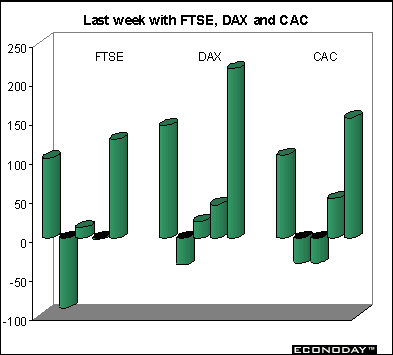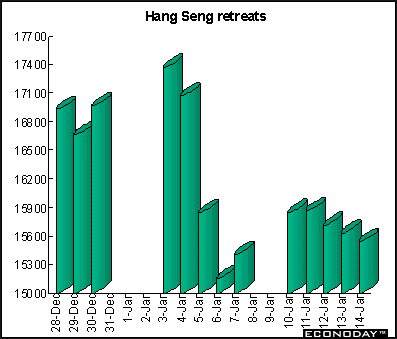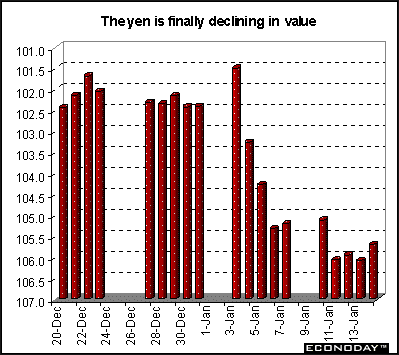 |
New Year's hangover
A International
Perspectives : January 17, 2000
By Anne D. Picker, International
Economist, Econoday
|
Markets steam ahead despite
interest rate jitters
Financial Markets
Equities
Equities in Asia and Europe ended the week mixed as profit
taking continued in some Asian markets after the end of year run
up. In Europe, all markets ended on the plus side despite inflation
and interest rate concerns. The America Online and Time Warner merger
affected overseas trading as well as U.S. trading. The overseas
markets continue to watch U.S. markets and new economic data very
closely. They fear potential ripple effects from events in the United
States on their own economies.
|
Selected
World Stock Market Indexes
|
|
|
|
|
|
|
|
|
|
|
|
1999
|
1999
|
Week
percent
|
|
|
Index
|
14-Jan
|
High
|
Low
|
Change
|
|
Asia
|
|
|
|
|
|
|
Australia
|
All Ordinaries
|
3131.60
|
3152.50
|
2804.80
|
2.86
|
|
Japan
|
Nikkei 225
|
18956.55
|
18934.34
|
13232.70
|
4.19
|
|
Hong Kong
|
Hang Seng
|
15542.23
|
16962.10
|
9076.33
|
0.88
|
|
S. Korea
|
KOSPI
|
948.03
|
1028.07
|
498.42
|
-0.07
|
|
Singapore
|
Straits
Times
|
2392.53
|
2479.58
|
1286.56
|
-0.56
|
|
|
|
|
|
|
|
|
Europe
|
|
|
|
|
|
|
Britain
|
FTSE 100
|
6658.20
|
6930.20
|
5770.20
|
2.36
|
|
France
|
CAC
|
5787.44
|
5958.32
|
3958.70
|
4.47
|
|
Germany
|
DAX
|
7173.22
|
6958.14
|
4668.50
|
5.78
|
|
|
|
|
|
|
|
|
North
America
|
|
|
|
|
|
|
United States
|
Dow
|
11722.98
|
11497.12
|
9120.70
|
1.74
|
|
Canada
|
TSE Comp
300
|
8357.50
|
8414.10
|
6180.30
|
-0.85
|
|
Mexico
|
Bolsa
|
7381.49
|
7129.88
|
3300.42
|
4.75
|
Europe
European market participants faced a skittish week. They
were confronted with the probability of a Bank of England interest
rate increase and the unveiling of the first of the major labor
union contract proposals in Germany. However, the markets shrugged
off the 25 basis point increase by the Bank of England — and they
pretty much ignored the large wage increase requested by the union.
Certainly the proposed merger between America Online and Time Warner
attracted attention away from the other issues.
Traders everywhere were buoyed
by tame U.S. inflation figures and investors' apparent indifference
to the prospect of an imminent rise in U.S. interest rate increase.
Analysts overseas said they were impressed that Federal Reserve
chairman Alan Greenspan, in Thursday night's speech, indicated that
he will not let inflation get in the way of a surging U.S. economy.

The Financial Times Stock Exchange
100-Share Index (FTSE) ended the week up 127 points or 2.4 percent
after the Bank of England raised its key interest rate from 5.5
percent to 5.75 percent. The French CAC jumped 248 points or 4.5
percent, continuing its positive streak to end the week at 5787.
The German DAX index scored
sharp gains on four of five trading days to close the week at a
record level of 7173, up 217 points or 5.8 percent on the week.
The DAX was driven by sharp gains in telecom and technology stocks
as the market's fascination with all things internet related continued
unabated. And with all the talk of interest rate increases elsewhere,
the equity markets on the continent became concerned that the European
Central Bank would raise rates as well because of improving European
growth.
Asia
Asian markets have been wary ahead of the Federal Reserve Open Market
Committee meeting on February 1st and 2nd.
Some fear the Fed could raise interest rates by as much as 100 basis
points to cool the hot U.S. economy. A large interest rate hike
would hurt Asia by luring money away from the region's riskier emerging
markets and into safe havens such as U.S. Treasuries. The recovering
economies are extremely sensitive to U.S. interest rate movements.

The Hong Kong Hang Seng index,
after a huge 443 point gain on Monday because of the America Online
and Time Warner merger, gave most of it back on profit taking as
the market ebbed lower on Wednesday, Thursday and Friday. The market
was exceedingly jittery about U.S. interest rates and concern that
the U.S. producer and consumer price reports would be inflationary.
(They weren't.)
The Nikkei 225 average finished
the week up 763 points or 4.2 percent. Foreign investors continued
to be net buyers of Japanese securities. Their persistent bargain
hunting kept shares well supported despite a poor outlook among
many local investors, traders said.
The Australian All Ordinaries
index soared to a record closing high Tuesday on the coattails of
rallying media stocks. The index gained 87 points or 2.9 percent
to end the week at 3131.6, a record high. News on Monday of the
merger between America Online and Time Warner sent local media stocks
flying offsetting the weight of profit taking in the broader market.
The index's performance is an indicator of the good Australian economic
performance.
Currencies
The currency markets were dominated by a number of factors last
week. Variously, they were the mega merger between America Online
and Time Warner and accompanying profit taking; disappointing German
economic statistics and the beginning of the union bargaining season
there; inflation and interest fears because of increased oil prices
and central bank actions and expected actions; exuberant stock markets
around the world; Alan Greenspan; and the up coming G-7 meeting.
And the list goes on…
Asia
Yen
The dominant talk about the yen last week centered on whether
the Japanese Finance Ministry would push its G-7 partners (United
States, Germany, France, the United Kingdom, Italy and Canada) for
help in weakening the yen further at the upcoming January 22nd
meeting in Tokyo. Japan continually voices concern about the currency's
strength, which could slow exports and hamper the country's nascent
economic recovery.

The recent weakening of the
yen has been attributed to several factors including rumors of covert
Bank of Japan intervention, hedge funds buying short dated dollar
calls, Japanese asset managers lifting some of the currency hedges
on foreign investments, and foreign profit taking on the Nikkei's
rise. In addition, the fact that the Bank of Japan has been draining
Y2K related excess liquidity from the money markets at a much slower
pace than the other central banks has been interpreted as easing
by the Bank of Japan.
The yen rises in value against
the dollar and euro when Japanese companies convert overseas proceeds.
During last week, exporters and trust banks have sold dollars and
euros to take advantage of more favorable rates to convert overseas
earnings and bring proceeds home.
Australian Dollar
The Australian dollar rose against the U.S. dollar as the strongest
hiring outlook among Australian businesses in 10 years indicated
further economic growth and fed expectations of higher interest
rates. The Australian economy is in its ninth year of growth, the
longest period of expansion since record keeping began four decades
ago. The Reserve Bank of Australia last increased interest rates
on November 3rd, lifting its official cash rate 25 basis
points to 5 percent. The policy setting board next meets on February
first and analysts widely expect another increase because of the
strong economy. Higher interest rates attract investors to a currency
because of the prospect for higher returns. Investors, betting the
Reserve Bank will raise rates next month, are watching for any indication
on the size of the increase.
Euro
The euro was sinking even before the release of the U.S. inflation
data and the Bank of England's announcement of a 25 basis point
interest rate increase. The favorable U.S. inflation data combined
with positive market reaction to Fed chairman Alan Greenspan's remarks
pushed the euro lower. Weaker than expected German data along with
higher than expected wage demands by the German metalworkers union
IG Metall on its 2000 pay round wage demands contributed to the
decline. The European Central Bank is watching the progress of the
German wage negotiations carefully for inflationary implications.
These negotiations are a precursor for other German labor contracts
and impact other countries' labor negotiations as well.

Bank of England…
The first shoe of what could be many fell on Thursday when the Bank
of England became the first central bank to raise interest rates
in the new century. The Bank raised the repo or major policy making
rate by 25 basis points to 5.75 percent, saying that increases in
wealth, labor income and household borrowing are suggesting that
consumer spending will continue to grow robustly. Economists said
it presaged similar rate increases in Europe and the United States
to forestall inflation at a time of accelerating global growth.
The increase had been widely
anticipated and did little to damp the enthusiasm in financial markets.

The decision to increase
borrowing costs had been widely expected, given Britain's strong
economic growth. Although the increase was met with disapproval
by many businesses and union leaders, there was some relief that
it had not been larger. The decision means higher borrowing costs
for homebuyers and businesses on one hand, but also higher income
for savers on the other.
The Monetary Policy Committee's
(MPC) role is to set interest rates at a level which keeps inflation
as close as possible to 2.5 percent. Inflation currently stands
at 2.2 percent but the process is complicated by the assumption
that interest rate changes take about two years to have an effect.
However, members of the MPC have been concerned about rising housing
prices, consumer spending and wages. It fears that if the economy
is left to grow unchecked, higher inflation will follow.
The latest indicators show
that consumer spending climbed in December and the housing market
continued to pick up speed. Unemployment is at its lowest level
for nearly two decades, which is seen as leading to increased wages
as employers aim to recruit and retain workers. Union leaders attacked
the interest rate rise, warning that firms will find it more difficult
to expand and export. City analysts gave warning that with house
prices and consumer spending continuing to rise steeply, the Bank
is set to make a series of further rises in the next few months.
The first increase could come as soon as next month, when the Bank
will be in the process of putting the finishing touches to its quarterly
Inflation Report.
Indicator Scoreboard…
European Monetary Union
October workday adjusted industrial production rose
2.1 percent on the year. The result is expected to be revised upward
because of statistical difficulties with the German industrial production
data. September output was revised up to show a 2.2 percent annual
increase compared to a 0.8 percent rise initially reported. All
EMU countries reporting data posted annual output increases. The
strongest increases were recorded in France (+3.4 percent), Spain
(+2.7 percent) and Italy (+2.5 percent). EMU output in October rose
in all sectors. The strongest growth rates were recorded in capital
goods, up 2.5 percent, and intermediate goods, up 2.4 percent.
November industrial producer
prices — excluding construction — jumped three percent from
2.1 percent in October, primarily because of oil price increases.
Third quarter gross domestic
product was unrevised from preliminary data showing a one
percent quarterly increase and a 2.3 percent increase when compared
with last year. The strong third quarter result was mainly due to
a pick up in private consumption and gross fixed capital formation.
While exports positively influenced third quarter GDP, a slower
pace of inventory accumulation had a negative contribution to growth.

Germany
November industrial production declined 0.5 percent
on the month. However, the Finance Ministry warned that output data
for October and November are likely distorted and are almost certain
to be revised up. The data contradict other recent economic indicators,
which show that the acceleration in German growth is continuing.
December seasonally adjusted
consumer prices increased 0.1 percent on the month
and 1.1 percent on the year. Seasonally adjusted CPI increases over
the last six months were revised down to an annualized rate of 1.5
percent in December from 1.7 percent originally estimated.
November unadjusted merchandise
trade surplus came in higher than most analysts expected.
Exports jumped 14.5 percent above a year earlier, while imports
were 16.8 percent higher. Both export and import levels were the
highest since pan German statistics began to be compiled in 1991.
The November seasonally adjusted trade surplus increased both on
a monthly basis and when compared with last year. The data suggest
that net exports will make another positive contribution to fourth
quarter GDP. Seasonally adjusted exports were 8.4 percent higher
than in October and imports were up 6.8 percent from a month earlier.
Gross domestic product
expanded by a real 1.4 percent in 1999, down from the 2.2 percent
growth rate in 1998. This result was slightly higher than the government's
revised 1999 GDP forecast of 1.3 percent. While the growth rate
this year was below last year's, it was within the range of average
annual real growth in the period between 1991 to 1998.
November seasonally and calendar
adjusted total real retail sales — including automobiles
and gas station sales — fell one percent and 3.1 percent on the
year. These data are more disappointing than the unadjusted figures
released earlier showing a 1.0 percent increase in real retail sales
compared with a year earlier. Calendar adjusted monthly figures
fell 2.1 percent, however. This comes as a surprise as retailers'
reports suggested early Christmas purchases were relatively strong.
France
December consumer prices increased 0.4 percent, after
no change in November and 1.2 percent when compared with last year.
Oil product prices increased 5.2 percent on the month and 20.5 percent
when compared with a year ago. This boosted energy prices 3.2 percent
on the month and 9.6 percent on the year. Excluding energy, the
CPI was up 0.2 percent on the month and 0.6 percent on the year.
Seasonally and workday adjusted
third quarter gross domestic product was unrevised
at one percent, as expected, after a 0.8 percent increase in the
second quarter. When compared with last year, third quarter growth
was revised to 2.9 percent.
Asia
Japan
December's wholesale price index was flat but was down 0.6 percent
on the year. Electrical equipment and transportation items declined
but edible agricultural, livestock and fishery products rose, as
did prices of petroleum and coal products.
November current account
surplus dropped 31 percent when compared with a year earlier.
The surplus has dropped year on year for 10 months in a row. Goods
and services trade for the month was down 35.3 percent. Exports
rose of 4.7 percent while imports jumped 16.2 percent when compared
with a year ago.
Australia
December employment jumped a seasonally adjusted 55,800.
This was much higher than analysts expected. Full time employment
jumped a healthy 46,300. However, December's unemployment
rate rose to seven percent from 6.7 percent in November,
because of the increased number of people joining the labor market
to look for jobs. The participation rate rose sharply to 63.6 percent
from 63.1 percent in October.
Endnote…
It was a light week for Asian and European economic data and so
the markets paid even more attention than usual to U.S. data. By
doing this, they acknowledged the important impact of U.S. economic
events on their own economies. As the old saying goes — when the
U.S. economy sneezes, Europe (and Asia) could catch a cold.
Looking ahead…
| Central
Bank Activities |
|
Jan 17
|
Japan |
Bank
of Japan Monetary Policy Committee Meeting |
| Jan 20 |
Japan |
Bank of Japan
Monthly Report |
| Jan 20 |
UK |
European Central
Bank Monetary Policy Committee Meeting |
| |
| International
Groups |
| Jan 22 |
G-7 |
Group of Seven
Finance Ministers meeting in Tokyo |
| |
|
The following indicators
will be released this week…
|
| Europe |
|
|
|
Jan 17
|
Germany |
Wholesale
Price Index (December) |
| Jan 18 |
EMU |
Gross Domestic
Product (Q3, 1999) |
| |
Italy |
Consumer Price
Index (December) |
| |
Germany
|
Trade
and Current Account Balance (November) |
| |
UK |
Industrial Production
(November) |
|
Jan 19
|
Germany |
Final
Consumer Price Index (December) |
| |
|
Wholesale Prices
(December) |
| |
UK |
Unemployment
(December) |
| |
Italy |
Industrial
Production (November) |
| Jan 20 |
UK |
Producer Price
Index (December) |
|
Jan 21
|
France |
Trade
Balance (November) |
| |
|
Industrial Production
(November) |
| |
| Asia |
|
|
| Jan 12 |
Japan |
Wholesale Prices
(December) |
| Jan 13 |
Australia |
Unemployment
Rate (December) |
| Jan 14 |
Hong Kong |
Retail Trade
(November) |
| |
| Americas |
|
|
| Jan 19 |
Canada |
Manufacturing
Survey (November) |
| |
Mexico |
Unemployment
(December) |
| Jan 20 |
Canada |
International
Trade (November) |
| Jan 21 |
Canada |
Consumer Price
Index (December) |
|